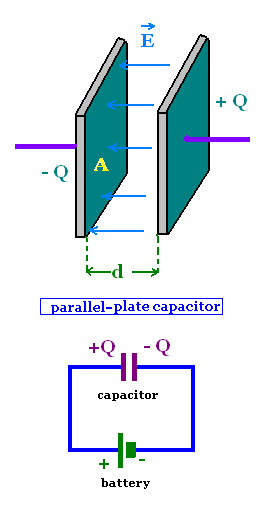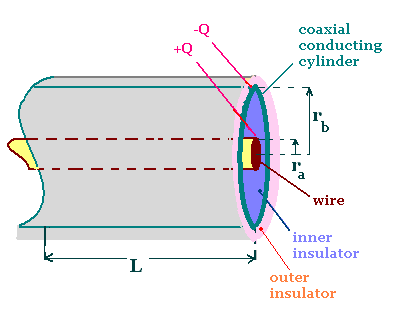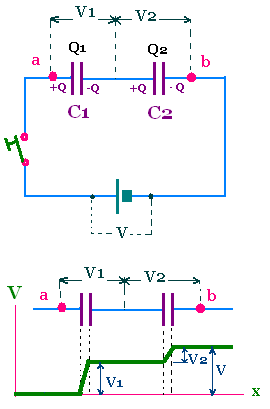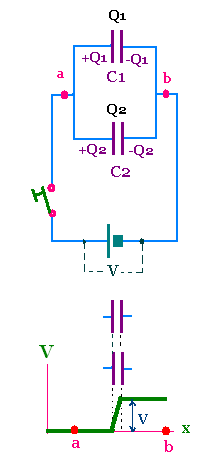|
Electrostatics
Electromagnetics
Electricity &
Magnetism
© The scientific sentence. 2010
|
Capacitors & insulators
1.Capacitor and capacitance

A capacitor is a device used in electric circuits.
Its main importance is the temporary storage of energy
in circuits. The capacitance is the ability of the
capacitor to store energy.
A capacitor consists of two nearby conductors referred to plates
separated from one another by an insulator, called
dielectric.
A capacitor can be charged by connecting its two wires from
the plates to the terminals of a battery. The battery pumps or moves
electrons from a plate to the other. Thus the first plate becomes
positively charged and the second becomes negatively charged.
The circulation of the electrons through the circuit cease to flow at a
certain time, the capacitor becomes charged, therefore the circuit
is in equilibrium and the potential difference between
the two plates of the capacitor and between the terminals of
the battery become equal: ΔV(Capacitor) = ΔV(Battery),
or simply V(C) = V(B), that is the voltages are the same. The
potential difference on the battery is the potential difference
across the capacitor.
At the equilibrium, the plates become charged with the charge +Q
and -Q. The plate with +Q is the positive charged plate connected
to the terminal + of the battery. The plate with -Q is the negative
charged plate connected to the terminal - of the battery.
Thus the two plates posses equal but opposite charge and the net
charge on the capacitor is zero. The charge Q on a capacitor
refers to the magnitude of the charge on each plate.
Experiments show that the more the potential difference
V across the capacitor is large, the more the charge Q
on the capacitor is large, and the relationship
between V and Q is proportional Q = C V.
The ratio C = Q/V is characteristic of a given capacitor. This
ration is called capacitance C of the capacitor.
Capacitance C of the capacitor:
C = Q/V
The capacitance is the measure of the ability of the capacitor
to hold charges on it. The SI unit of capacitance is Coulombs/Volts
(C/V), called a Farad (F). 1 F = 1 C/V.
The Farad is a large unit of capacitance. Typically, in
electric circuits, the capacitance of capacitors ranges from 10-12 F
or 1 pF (picofarad) to 10-6 F or 1 µF (microfarad)
2. Capacitance of parallel-plate capacitor
We have seen the potential difference across
the parallel-plate capacitor is
V = E d , and E = σ/εo, with
σ = Q/A.
Therefore
V = E d = Q/C . Hence
C = Q/Ed = (σ A)/(σ/εo)d =
A εo/d
Capacitance C of a parallel-plate capacitor:
C = A εo/d
A is the area of the plate and d is the plate separation
of the capacitor. εo is the permittivity of
free space (or vacuum), that is the medium between the two plates.
3. Capacitance of cylindrical capacitor

We treat the wire as the positive plate and the cylinder
as the negative plate.
We have seen
the field near a long line charge is
E (r) = λ/2πεor, with
λ = Q/L, and r is the distance from the wire to
a point outside the wire.
The potential difference between the wire of radius
ra and the cylinder of radius rb is:
Or
| |
rb
| |
| V = Va - Vb = ∫ | E |
dr
|
| |
ra
| |
=
| |
rb
| |
| λ/2πεo ∫ | (dr/r) |
= (λ/2πεo) ln(rb/ra) =
(Q/2πεoL) ln(rb/ra)
|
| |
ra
| |
Therefore
C = Q/V = (2πεoL) / ln(rb/ra)
Capacitance C of a cylindrical (coaxial) capacitor:
C = (2πεoL)/ln(rb/ra)
4. Combination of capacitors
As cirduit elements, capacitors can be connected in series or
in parallel.
4.1. Capacitors connected in series
Electrical devices in series, general rule:
The potential difference across elements connected in series
in an electric circuit is the sum of the the potential
differences across the individual elements.
Consider two capacitors of capacitance C1 and C2 connected
in series.
 Under electrostatic conditions, the potential is uniform
along the connecting wires. The potential
varies from the point a to the point b. The potential
difference across both V = Vb - Va is
equal to the sum of the potential difference across each
capacitor V = V1 + V2.
Under electrostatic conditions, the potential is uniform
along the connecting wires. The potential
varies from the point a to the point b. The potential
difference across both V = Vb - Va is
equal to the sum of the potential difference across each
capacitor V = V1 + V2.
The two capacitors are initially uncharged, thus the region
between them has a zero net charge, thus the two capacitors
have the same charge Q = Q1 = Q2.
Now, we are interested to find the equivalent capacitance C12
fo the series combination of capacitors 1 and 2.
The equivalent capacitance of a combination of capacitors
is the capacitance of a single capacitor wich, when used in place
of the combination, provides the same external effect as
the replaced capacitors. For the capacitors in series, this
single capacitor must have the same charge Q under the same
potential difference V. That is
If C1 = Q/V1 and C2 = Q/V2, Using V = V1 + V2, we
have then:
V = V1 + V2 = Q/C1 + Q/C2 = Q(1/C1 + 1/C2) = Q/C12
Therefore
1/C12 = 1/C1 + 1/C2
Generally, the equivalent capacitance Ceq of a combination
of many capacitors in series is such that:
1/Ceq = Σ (1/Ci). Where Ci
is the individual capacitance.
Equivalent capacitance Ceq of a combination
of any number of capacitors connected in series:
1/Ceq = Σ (1/Ci)
4.2. Capacitors connected in parallel
Electrical devices in parallel, general rule:
The potential difference across elements connected in parallel
in an electric circuit is the same.

Let two capacitors of capacitances C1 and C2
connected in parallel. To provide the same external
effect as capacitors 1 and 2 in parallel, a single capacitor
with capacitance C12 , which will replace them, must have
charge Q = Q1 + Q2 under the potential difference V. That is
C12 V = C1 V + C2 V = (C1 + C2) V
Therefore
C12 = C1 + C2
In general, the equivalent capacitance Ceq of many
capacitors connected in parallel is:
Ceq = ΣCi
Equivalent capacitance Ceq of any number os
capacitors connected in parallel:
Ceq = Σ Ci
5. Electric energy
5.1. Electric energy stored in a capacitor
When a battery charges a capacitor, the battery does work on
the charges carriers, as it transfers them from the plate
to the other, raising their potential energy. This is the
electric energy stored in the capacitor.
Let U represent the energy of the capacitor after it has
been charged to the final charge Q and final potential
difference V, Q' and V' represent these quantities as they
vary during the charging process.
During the charging process Q' varies while the battery
transfers charge from a plate to the other, hence V' varies.
The potential V is the potential energy U per unit charge dQ.
At some instant during the charging process, the change in the
potential energyis dU' = V'dQ'
Using V' = Q'/C , where C is the capacitance of the capacitor,
we write:
dU' = V'dQ' = (Q'/C) dQ'
To find the potential energy U in the capacitor after being
charged, we integrate dU':
| |
Q
| |
| U = ∫ | |
(Q'/C) dQ = (1/2C) Q2
|
|
0
| |
Energy stored in a charged capacitor:
U = Q2/2C = CV2/2 = QV/2
5.2. Energy density of an electric field
We have associated the energy of the capacitor with
the potential energy of the charges. This energy can
be attributed to the electric field that exists between
the plates.
We take the case of the parallel-plate capacitor in which the
capacitance is C = A εo/d, and V = E d, we obtain:
U = CV2/2 = A εoV2/2d =
εoE2(Ad)/2
The factor (Ad) is the volume of vacuum between the plates occupied
by the electric field E. Therefore,
the energy density, that is the energy per unit volume is
u = U/(Ad) = εoE2/2
Hence
The energy density between two acculations of charge distribution
separated by vacuum is
u = εoE2/2
Energy density of an electric field:
u = εoE2/2
|
|